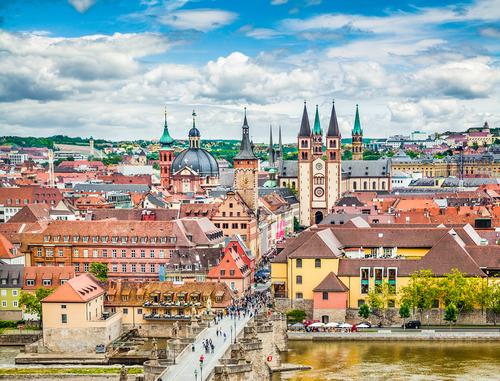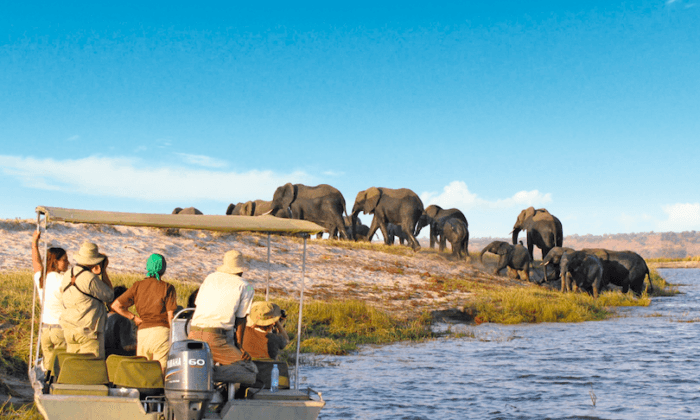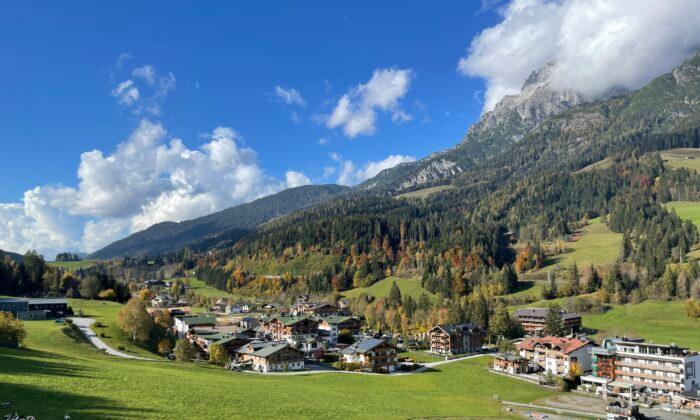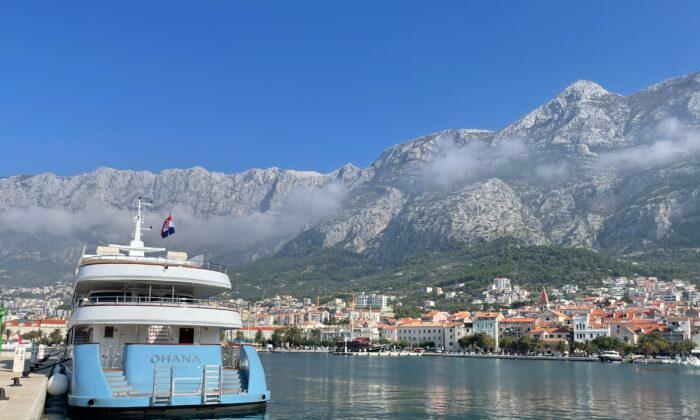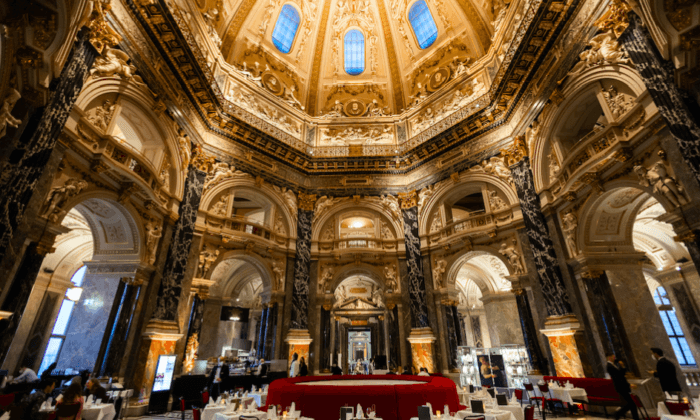WÜRZBURG, Germany—It’s dark here in the cellars, but tall candles mounted on huge wine casks light our path. We’re deep in the Staatlicher Hofkeller, the cellars of the Bavarian state winery below Würzburg Residenz Castle, a World Heritage Site in Franconia.
While Germany may be known for its beer, in this region of Bavaria, wine heritage runs deep. Wine has been cultivated in Franconia for more than a thousand years, and vineyards cover the hills and countryside. Winemaking families here have honed their craft for centuries and can still be found in the region’s medieval villages.
Franconia’s obvious treasure is its white wine, which dominates the region. The most popular local favorite is Silvaner, a fruity wine that is perfect on a warm, summer day. Wine is bottled in the Bocksbeutel, a short round bottle that is uniquely Franconian.
What Is Franconia?
You won’t find Franconia on a map, and there is no political unit called Franconia. Instead, it’s a cultural identity that reaches back to the day when Germany was many tribes. The Franken were a tribe that eventually became a separate duchy of the Holy Roman Empire.
Today, Franconia is part of the German state of Bavaria. Yet its unique heritage is still evident in its dialect, culture, and traditions. Ask almost any Franconian and he or she will tell you, with a smile, that they are Franconian first, and Bavarian second.
In other parts of Germany, locals go to the beer garden for relaxation. Here in Franconia, folks head to the wine cellar. It only seems fitting then, to be sitting in the cellars of a beautiful castle drinking Silvaner. The Staatlicher Hoffkeller Würzburg has been making wine since 1128, making it one of the oldest wineries in the world. With a wine heritage like that, you can bet they know what they’re doing.
Road Trip in Franconia
One of the best ways to explore Franconian Wine Country is by car. Our road trip had started off with a stop in Volkach, a village of 9,000 surrounded by vineyards. Generations of winemakers still make their home here. The Max Müller Winery is one example. While their tasting room is contemporary, their classical wines combine time-honored traditions with modern winemaking. Wines are stored in the historical baroque cellars below the main house.
Some 7,000 winemaking families farm vineyards in Franconia today. Most have small plots of land, some on steep gradients. Though labor intensive, this steep land produces high-quality wine.Though small winemakers can struggle with distribution, in the nearby town of Sommerach, they have an excellent solution. Founded in 1901, Winzer Sommerach is a winemaking co-op that allows winemakers to create and distribute their wine. Sommerach has a modern tasting room and outdoor patio seating where you can enjoy your wine in the summer air.
Next Stop: Bayreuth
Franconia is also rich with culture. In the small wine-making town of Bayreuth, that heritage is on grand display. Bayreuth was the home of 19th-century German composer Richard Wagner. Wagner was drawn to Bayreuth for its musical prominence and established the Festspielhaus, an opera house where he showcased his work.
The Bayreuth Festival is a music festival held annually, presenting performances of Wagner’s operas. Wagner’s home is open to visitors interested in learning more about the life of the composer.
But while many come to Bayreuth for Wagner, I’m most excited to see the Margravial Opera House. Built in 1746–1750 by Princess Wilhelmine for her daughter’s marriage, it has been called the most beautiful baroque theater in Europe.
Named a UNESCO World Cultural Heritage Site, the Margravial Opera House has been beautifully preserved. In 2012, work began to carefully restore the opera house. Some 93,000 hours of work later, the Margravial Opera House reopened in 2018.
I’m lucky enough to get tickets for an opera. With so many intricate wood carvings and artistic creations in the theater, it’s hard to know where to look. While the opera on stage is very good, my eyes keep going back to the theater itself. It’s not every day that you can sit for a few hours, surrounded by such a beautiful creation.
Nuremberg Past and Present
Nuremberg is Franconia’s best-known city, and it’s my last stop. Nuremberg’s Christmas market is world-renowned. Each year, travelers from around the world flock to the Christkindlesmarkt on Hauptmarkt in the old quarter.
Today the square is filled with vendors selling farm-fresh produce. I catch the faint scent of gingerbread in the breeze. That’s because Wicklein Lebkuchen, one of Nuremberg’s most famous gingerbread makers, is just steps away.
Nuremberg was once an important stop along the Spice Route, and spices like cinnamon and ginger were an important ingredient in local foods. Wicklein Lebkuchen offers a gingerbread workshop, where you can make and decorate your own Elisenlebkuchen (a large gingerbread cookie), while learning from an expert.Old Town Nuremberg
Though Nuremberg is large (500,000 residents), it’s best to explore its historic inner core by foot. Much of the city was destroyed during World War II, but its medieval core has been rebuilt in the original style.
We stop for traditional Nuremberg bratwurst, thin grilled sausages which are a specialty of Nuremberg, at the Artisan Courtyard, an artisan village near the City Gate. Then we make our way to the shopping quarter, one of the biggest pedestrian shopping areas in Europe.
Eventually, we hike up the hill to the Imperial Castle. During the Middle Ages, the castle was an important part of the Holy Roman Empire. It housed the Empire’s head of state. A detailed exhibition called “Emperor-Empire-City” shows how the Holy Roman Empire worked.
An Obligation to the Past
Nuremberg has a complex and difficult history. Beginning in 1927, the National Socialists used it for their party rallies. When Hitler seized power, he built large Nazi parade grounds in Nuremberg.
That is why the city was bombed without mercy in January 1945. At the end of the war, Nazi war criminals were tried here before the International Military Tribunal.
Today, you can visit the courtroom where the Nuremberg Trials took place. Still a working courtroom, the building also houses the Memorium Nuremberg Trials museum.
The “Fascination and Terror” exhibit at the Nazi Party Rally Grounds does not whitewash the past. Nuremberg has made a commitment to promoting peace and calls itself a “City of Peace and Human Rights.” Every other year, it awards the Nuremberg International Human Rights Award to someone globally working for human rights.Franconian Wine Country
You could spend weeks exploring this unique wine region in Bavaria, but I’ve seen a lot during my week here. As I head out of town the next morning, I pass lush green vineyards, ripe for harvest.
Four bottles of Franconian wine lie carefully wrapped in my suitcase. Someday, I’ll pull them out at home to enjoy, a perfect reminder of my time in Franconian wine country.
Janna Graber has covered travel in more than 45 countries. She is the editor of three travel anthologies, including “A Pink Suitcase: 22 Tales of Women’s Travel,” and is the managing editor of Go World Travel Magazine.

